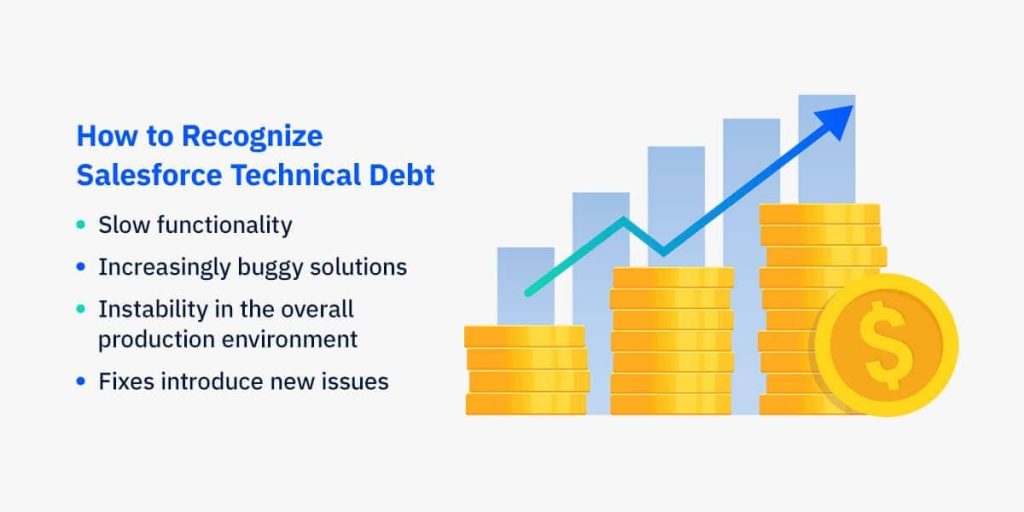Technical debt in Salesforce is unavoidable. It’s a time-sensitive environment with pressure to get up and running as soon as possible. While ignoring problems can be tempting, doing so can have far-reaching long-term consequences, including potentially expensive Salesforce technical debt cleanup.
Understanding Salesforce technical debt is critical to minimizing its effects. Organizations must know the difference between good and bad technical debt and be familiar with the tools to manage it. With the correct application, taking the appropriate steps and using code quality tools can ensure the health and functionality of your Salesforce orgs.
What Is Technical Debt in Salesforce?
Technical debt is the cost of choosing a quick solution over a slower, more efficient approach. If managed correctly from the outset, it speeds up software development, meets deadlines, and positively impacts your business.
Like any debt, technical debt requires repayment to prevent it from becoming so severe it requires architect intervention or crashes your Salesforce org altogether. Businesses should minimize technical debt to ensure smooth operations and minimal interruptions.
The Difference Between Good + Bad Salesforce Technical Debt
As Salesforce technical debt is inescapable, Salesforce-based businesses must engineer their strategies around maximizing good debt and minimizing bad debt. The differences include the following.
- Good technical debt: Good technical debt refers to the time and work businesses must invest to ensure quality developments in a streamlined, continuous process. You can release changes quicker, be more flexible, and respond to sales opportunities.
- Bad technical debt: Rushed development processes and disconnected teams can result in bad technical debt. Taking too many shortcuts while chasing release dates can hinder your release processes and impact your organization’s health, impeding your ability to keep up with your customers’ needs.

How to Recognize Salesforce Technical Debt
Recognizing technical debt is the first step to managing and removing it. Some of the common signs of significant technical debt include the following:
- Slow functionality
- Increasingly buggy solutions
- Instability in the overall production environment
- Fixes introduce new issues
Types of Technical Salesforce Debt
You’re generally looking at two categories of technical Salesforce debt—deliberate and accidental. In many cases, it’s possible to plan and mitigate the effects of technical debt. Here are the typical types of technical debt.
- Deliberate: This type of technical debt occurs when a team consciously generates a manageable amount of technical debt, fully understanding the risks and managing the associated costs. Precision is critical with planned technical debt to understand the necessary compromises and minimize the adverse effects.
- Accidental: Unintentional technical debt occurs due to mistakes, lack of knowledge, and poor-quality code choices made to expedite releases. Poor communication and lack of cohesiveness within organizations and DevOps teams are one of the primary causes of accidental technical debt.
With proper foresight and management, deliberate and accidental technical debt can be manageable, especially if discovered in the early stages of the DevOps pipeline.
The Four Quadrants of Technical Debt
There are four root causes of technical debt. Martin Fowler introduced this categorization process, which includes reckless, prudent, deliberate, and inadvertent quadrants. Assigning your technical debt into these four categories helps you understand code challenges by delving deeper into their background and intent.
- Prudent and deliberate: When the benefits of a quick delivery outweigh the risks of technical debt in decision-making, teams take a calculated risk and deliver the project with the full knowledge they must address the consequences later.
- Reckless and deliberate: When teams are aware of technical debt and choose to avoid the consequences, you can categorize this as reckless and deliberate. It may cause significant challenges and higher costs in the future.
- Prudent and inadvertent: Teams learn about implementation errors after they deliver the product to the end user.
- Reckless and inadvertent: When a team needs more knowledge and experience around best practices, they accumulate unintentional debt, which becomes progressively challenging to manage.
What Causes Technical Debt in Salesforce?
Avoiding bad technical debt begins with a thorough understanding of the causes. Managing your technical debt is always a balancing act. There are several causes of bad technical debt in the Salesforce context.
- Lack of established processes: Lack of actionable processes can result in erratic data model design and refactoring when creating and updating existing data models.
- New releases: If new platform functionality overrides features from previous releases or custom developments, it could create significant technical debt to align functionalities.
- Outdated or changed designs: As your business needs change, you might wish to phase out some functionalities. It may be safer to leave the functionality in, but it can cause challenges in the future.
- Poor coding practices: Using poor coding practices for speed when configuration options are available.
- Inapplicable integrations: Integrations should be deliberate and meaningful, and adding irrelevant integrations could result in them performing actions teams are unaware of and, therefore, cannot control.
- Poor data quality: Settling for sub-quality data can cause app crashes and failed deployments requiring significant time and labor.
- Bolt-on technical debt: When teams extend a specific functionality in increments instead of a comprehensive rebuild, it can cause eventual crashes and other bad technical debt.

Why Is Minimizing Salesforce Technical Debt Essential?
Bad technical debt can be time-consuming and expensive to repair. The results of not investing the time and steps required to achieve streamlined processes can be challenging. Whether striking the balance of priorities between pressure to provide new functionalities and creating longevity is worth it depends entirely on the situation.
When bad technical debt builds up, it can cause significant release delays. In some cases, teams need to discard old processes and rebuild from scratch. Regardless, bad technical debt is frustrating for your team and users and detrimental to your business’ responsiveness, which affects your bottom line.
Some of the consequences of bad technical debt include the following:
- Extended load times and errors.
- Instability in the overall Salesforce environment.
- Lack of access to features, reports, and other critical information.
- Additional bugs.
- Inability to navigate systems correctly.
- Unexpected appearances of previous, outdated solutions.
How to Decrease Bad Technical Debt in Salesforce
The sooner you tackle your bad Salesforce debt, the better. In many cases, you can turn things around with some careful planning and decisive actions. Some steps you can take to minimize bad Salesforce debt include the following.
1. Take an Org Inventory
Stay abreast of what is in your orgs by taking regular inventory. Use a metadata dictionary to provide analytics on where bad technical debt is causing the most damage. Even if you know where the challenges are, attaching metrics is an excellent method to begin a Salesforce technical debt cleanup.
Once you have gathered the relevant data, you can determine your customizations’ shelf life, remembering the need for regular updates.
2. Begin a Salesforce Technical Debt Cleanup
Once you’ve highlighted the problem areas with slow development, crashes, or limited ability to use Salesforce, document optimization opportunities as they arise. Prioritize unused packages, as they slow down your processes and cost you money.
3. Use Extensive Documentation
Well-documented Salesforce flows can save you valuable time and money when conducting impact analyses for future releases. Something as simple as writing things down can protect against downtime caused by unexpected incidents.

How Code Quality Tools Assist Minimize Bad Technical Salesforce Debt
The quality of your code is the driving force behind your Salesforce success. Errors in coding structure have far-reaching consequences, including the buildup of bad technical debt. Using code quality tools in Salesforce development has several benefits.
Improving User Experience
Your business DevOps projects primarily aim to provide valuable and user-friendly experiences. Functional failures can alienate users and reflect poorly on your business initiatives.
Code quality tools minimize bad technical debt by identifying issues in your coding structure that could create bugs and impact the user experience. These can help avoid repetitive and unnecessary work or unanticipated holdups when releasing a product or update.
Improving Release Cycles
Expediting DevOps services can often come at the cost of bad technical debt, as performing manual processes on a strict deadline frequently results in human error. However, taking too much time to provide new releases may be a competitive disadvantage, so striking the correct balance between quality and speed is essential.
Automating DevOps processes allows your team to maintain the quality of applications and updates and keep up with fast deliveries. DevOps tools like CI/CD and static code analysis ensure high-quality development and increase your ability to release Salesforce development projects.
Code quality tools allow you to streamline your DevOps pipeline, create better products, lower costs, and increase data security.
Saving Time
One of the most significant components of technical debt is the time it takes to rectify errors. When juggling multiple projects, delays have a ripple effect, impacting all your releases. Code quality tools are the most powerful method of reducing technical debt, minimizing coding errors and freeing your team up to focus on new releases.
Your team must conduct testing to find and repair coding errors, and manual testing is labor-intensive and time-consuming, which isn’t sustainable in the long term. Automating code quality tests saves time on both ends of your DevOps pipeline.
Reducing Costs
Bad technical debt can be expensive. When users are happy, your business can earn higher profits. If your developments and applications don’t provide an ROI on the cost of producing them, they can harm your business.
Positive ROI is about balancing quality and minimizing costs, and finding coding errors late in the process results in more expenditure to fix them. Code quality tools can find mistakes in real time, costing significantly less to remedy.
Ensuring Minimal Deployment Impact
Throughout the DevOps pipeline, there are numerous testing points to ensure functionality. Many environments use manual testing, which allow human error and shortcuts to invalidate parts of the process. Automation will enable you to test every line of code on the fly, ensuring nothing slips through and causes avoidable bad technical debt.
Static code analysis tools like CodeScan are easy to integrate with IDE plugins and CI/CD pipelines and have over 600 rules to earmark bugs and vulnerabilities that could cause technical debt.
How to Increase Good Technical Debt in Salesforce
Good technical Salesforce debt enables faster releases, yielding more significant ROI. Consider the following methods to increase good technical debt.
- Plan: Properly managed technical debt can be positive. Accepting that releases accumulate technical debt allows you to efficiently prepare for a change review or backlog management process to mitigate some adverse outcomes.
- Promote collaboration: Promoting team collaboration assists in implementing uniform processes for data model design and refactoring.
- Optimize configuration: Avoid adding unnecessary code that could slow down processes and have other adverse effects.
- Adopt a documentation policy: Create a policy that requires documenting all changes. Then, you’ll have an accessible modification history to refer to if you need to troubleshoot.
- Avoid over-customization: Over-customization can deliver code that doesn’t pass Salesforce’s threshold or promote changes.
- Keep the rules updated: Update your data validation rules to mitigate the risk of downtime and process delays.
- Conduct regular reviews: Take the time to analyze integrations and managed packages regularly and decommission outdated or unnecessary integrations.
- Manage your requirements: Sometimes, user requests don’t make developmental sense. Foster open discourse around what will work and what will cause a disproportionate impact.
- Schedule regular cleanups: Implement and stick to a standard cleanup routine to remove duplicate records and data enrichment, standardization, and validation.
- Ensure data quality: Follow best practices like defining data governance policies, establishing validation rules, and monitoring and reinforcing data quality standards for adequate change management.
Minimize Technical Debt in Salesforce With AutoRABIT
AutoRABIT prioritizes helping Salesforce development teams produce quality work without sacrificing speed and security, and minimizing technical debt is a fundamental part of achieving this goal. Our suite of release management tools is the most comprehensive on the market. Combined with the CodeScan solution, you can take your DevSecOps processes to a new level.
If you would like to learn more about how AutoRABIT can help you minimize technical debt for faster and more secure deployment, please request a demo today and see firsthand what AutoRABIT and CodeScan can do for your business.
